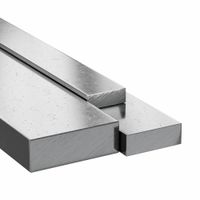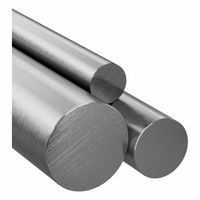Call +(254) 703 030 000 / 751 483 999 / 721 704 777
- Home
- Raw Materials
- Metals
- Alloy Steel
- Alloy Steel Bars Rods
.....Read More
Frequently Asked Questions
What are the main applications of alloy steel bars and rods?
Alloy steel bars and rods are used in a variety of applications due to their enhanced mechanical properties, such as increased strength, toughness, and resistance to wear and corrosion. Here are the main applications:
1. **Automotive Industry**: Alloy steel bars and rods are used in the manufacturing of components like crankshafts, gears, axles, and connecting rods due to their ability to withstand high stress and fatigue.
2. **Construction**: They are used in the construction of buildings, bridges, and other infrastructure projects. Their high tensile strength and durability make them ideal for reinforcing concrete and structural frameworks.
3. **Aerospace**: In the aerospace sector, alloy steel is used for making landing gear, engine components, and structural parts of aircraft due to its high strength-to-weight ratio and resistance to extreme temperatures.
4. **Oil and Gas Industry**: Alloy steel bars and rods are used in drilling equipment, pipelines, and offshore platforms. Their corrosion resistance and ability to withstand high pressure and temperature make them suitable for harsh environments.
5. **Tool Manufacturing**: They are used in the production of tools and dies, such as drill bits, cutting tools, and molds, due to their hardness and wear resistance.
6. **Machinery and Equipment**: Alloy steel is used in the manufacturing of industrial machinery and equipment, including shafts, bearings, and fasteners, due to its strength and durability.
7. **Railway**: In the railway industry, alloy steel is used for making rails, wheels, and other components that require high strength and wear resistance.
8. **Energy Sector**: They are used in power plants and renewable energy systems for components like turbines and generators, where high performance and reliability are crucial.
These applications leverage the unique properties of alloy steel to enhance performance, safety, and longevity in demanding environments.
How are alloy steel flat bars different from rods?
Alloy steel flat bars and rods differ primarily in shape, application, and sometimes in their manufacturing processes.
1. **Shape and Dimensions**:
- Flat bars are rectangular in cross-section, with a flat surface and uniform thickness. They come in various widths and thicknesses.
- Rods are cylindrical, with a circular cross-section, and are available in various diameters.
2. **Applications**:
- Flat bars are often used in construction, structural applications, and manufacturing of frames, supports, and braces due to their flat surface and ability to be easily welded and drilled.
- Rods are typically used in applications requiring tensile strength, such as in the manufacturing of fasteners, shafts, and axles. They are also used in machining and forging processes.
3. **Manufacturing Process**:
- Flat bars are usually produced by hot rolling or cold drawing, where the steel is passed through rollers to achieve the desired thickness and width.
- Rods are often produced through hot rolling, cold drawing, or extrusion, where the steel is shaped into a cylindrical form.
4. **Mechanical Properties**:
- Both flat bars and rods can be made from various alloy steels, which can be tailored to enhance properties like strength, hardness, and corrosion resistance. However, the specific properties can vary based on the alloy composition and heat treatment.
5. **Usage in Fabrication**:
- Flat bars are easier to cut and weld due to their flat surfaces, making them suitable for fabrication and assembly.
- Rods, being round, are more suited for applications where rotational symmetry is required, such as in bearings and gears.
These differences make each suitable for specific applications, depending on the structural and mechanical requirements of the project.
What are the benefits of using alloy steel in industrial applications?
Alloy steel offers several benefits in industrial applications:
1. **Enhanced Strength and Durability**: Alloying elements like chromium, nickel, and molybdenum increase the tensile strength and toughness of steel, making it suitable for high-stress applications.
2. **Improved Corrosion Resistance**: Elements such as chromium and nickel enhance resistance to rust and corrosion, extending the lifespan of components in harsh environments.
3. **Heat Resistance**: Alloy steels can withstand high temperatures without losing strength, making them ideal for applications like power plants and automotive exhaust systems.
4. **Wear Resistance**: The addition of elements like manganese and silicon improves wear resistance, reducing maintenance costs and downtime in machinery and tools.
5. **Versatility**: Alloy steels can be tailored to specific needs by adjusting the type and amount of alloying elements, offering flexibility in design and application.
6. **Cost-Effectiveness**: While initially more expensive than carbon steel, the durability and reduced maintenance needs of alloy steel can lead to cost savings over time.
7. **Machinability and Formability**: Certain alloy steels are designed to be easily machined and formed, facilitating manufacturing processes and reducing production time.
8. **Fatigue Resistance**: Alloy steels can endure cyclic loading and unloading, making them suitable for components subjected to repeated stress, such as springs and gears.
9. **Impact Resistance**: The toughness of alloy steel allows it to absorb energy from impacts, reducing the risk of sudden failure in critical applications.
10. **Customizable Properties**: By varying the alloying elements, properties like hardness, ductility, and tensile strength can be customized to meet specific industrial requirements.
These benefits make alloy steel a preferred choice in industries such as construction, automotive, aerospace, and manufacturing.
How does the rolling process affect the properties of alloy steel bars?
The rolling process significantly influences the properties of alloy steel bars by altering their microstructure and mechanical characteristics. During rolling, steel bars are passed through a series of rollers, which compress and elongate the material, refining its grain structure. This mechanical deformation enhances the strength and hardness of the alloy through a process known as work hardening or strain hardening. The rolling process also improves the ductility and toughness of the steel by breaking down coarse grains into finer ones, which enhances the material's ability to withstand stress and deformation without fracturing.
Additionally, rolling affects the directional properties of the steel, introducing anisotropy. The alignment of grains in the direction of rolling can lead to improved tensile strength and impact resistance along that axis, while properties perpendicular to the rolling direction may differ. This directional dependence is crucial for applications requiring specific mechanical properties.
The temperature at which rolling is performed—hot or cold—also plays a critical role. Hot rolling, conducted above the recrystallization temperature, allows for easier shaping and reduces residual stresses, but may result in a rougher surface finish. Cold rolling, performed below the recrystallization temperature, enhances surface finish and dimensional accuracy, and further increases strength through additional work hardening.
Furthermore, rolling can influence the alloy's corrosion resistance and fatigue strength. The refined grain structure and reduced porosity from rolling can enhance resistance to environmental degradation and cyclic loading. Overall, the rolling process is a vital step in tailoring the mechanical and physical properties of alloy steel bars to meet specific application requirements.
What are the common grades of alloy steel used in bars and rods?
Common grades of alloy steel used in bars and rods include:
1. **4140**: Known for its toughness, good fatigue strength, and abrasion resistance. It is often used in automotive and industrial applications.
2. **4340**: Offers high strength, toughness, and wear resistance. It is used in aerospace and other high-stress applications.
3. **8620**: Known for its good case hardening properties, it is used in gears and other components requiring a hard surface and a tough core.
4. **4130**: Offers a good balance of strength, toughness, and weldability. It is commonly used in the aerospace and motorsports industries.
5. **6150**: Known for its high strength and toughness, it is often used in applications like springs and torsion bars.
6. **4145**: Similar to 4140 but with higher carbon content, providing increased strength and hardness. It is used in oil and gas drilling equipment.
7. **5160**: Known for its excellent toughness and fatigue resistance, it is often used in leaf springs and other suspension components.
8. **52100**: Offers high hardness and wear resistance, making it suitable for bearings and other high-wear applications.
9. **9310**: Known for its high core strength and toughness, it is used in gears and other high-stress components.
10. **Cr-Mo (Chromium-Molybdenum) Steels**: These include various grades like 4130 and 4140, known for their strength, toughness, and resistance to high temperatures.
These grades are selected based on the specific mechanical properties required for the application, such as tensile strength, hardness, toughness, and resistance to wear and fatigue.
How do you choose between hot rolled and cold rolled alloy steel?
Choosing between hot rolled and cold rolled alloy steel depends on several factors:
1. **Surface Finish**: Cold rolled steel has a smoother, more refined surface finish, making it ideal for applications where aesthetics are important. Hot rolled steel has a rougher surface, suitable for applications where finish is not a priority.
2. **Dimensional Tolerances**: Cold rolled steel offers tighter dimensional tolerances and better precision, which is crucial for applications requiring exact measurements. Hot rolled steel is less precise due to the cooling process.
3. **Mechanical Properties**: Cold rolling increases the yield strength and hardness of the steel through strain hardening. This makes it suitable for applications requiring higher strength and durability. Hot rolled steel is more malleable and easier to work with, making it suitable for structural components.
4. **Cost**: Hot rolled steel is generally less expensive due to its simpler manufacturing process. Cold rolled steel is more costly because of the additional processing steps.
5. **Size and Shape**: Hot rolled steel is available in larger sizes and shapes, making it suitable for large structural components. Cold rolled steel is typically available in smaller sizes and is ideal for precision parts.
6. **Application**: Consider the end-use of the steel. For construction and structural applications, hot rolled steel is often preferred. For automotive parts, appliances, and furniture, cold rolled steel is more suitable due to its superior finish and strength.
7. **Production Volume**: For large production volumes, the cost-effectiveness of hot rolled steel may be advantageous. For smaller, high-precision projects, cold rolled steel may be more appropriate.
Evaluate these factors based on your specific requirements to make an informed decision.
What are the typical dimensions and sizes available for alloy steel bars and rods?
Alloy steel bars and rods are available in a variety of dimensions and sizes to suit different industrial applications. The typical dimensions include:
1. **Diameter**: Alloy steel bars and rods are commonly available in diameters ranging from 6 mm to 500 mm. Smaller diameters are often used for precision applications, while larger diameters are used in heavy-duty applications.
2. **Length**: Standard lengths for alloy steel bars and rods are typically 3 meters, 6 meters, or 12 meters. However, custom lengths can be produced based on specific requirements.
3. **Shapes**: Alloy steel bars and rods come in various shapes, including round, square, hexagonal, and flat. Round bars are the most common, used in a wide range of applications. Square and hexagonal bars are often used in manufacturing and construction, while flat bars are used in structural applications.
4. **Tolerances**: The dimensional tolerances for alloy steel bars and rods depend on the manufacturing standards, such as ASTM, AISI, or DIN. These standards specify the permissible variations in dimensions to ensure consistency and quality.
5. **Surface Finish**: Alloy steel bars and rods can have different surface finishes, such as hot-rolled, cold-drawn, or polished, depending on the application requirements.
6. **Grades**: Alloy steel bars and rods are available in various grades, each with specific chemical compositions and mechanical properties. Common grades include 4140, 4340, and 8620, each suited for different applications based on strength, toughness, and wear resistance.
These dimensions and sizes allow alloy steel bars and rods to be used in diverse applications, including automotive, construction, machinery, and tool manufacturing.




